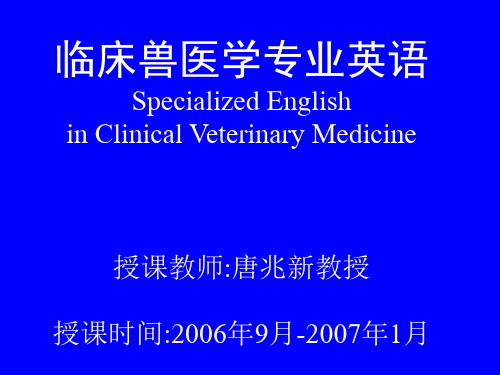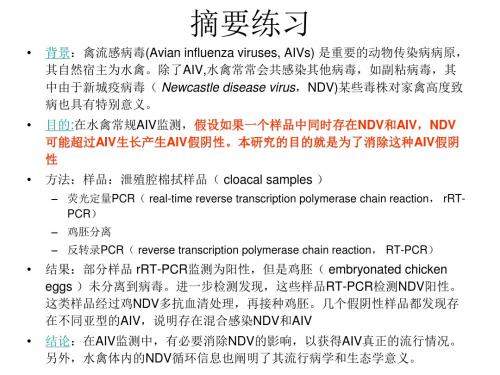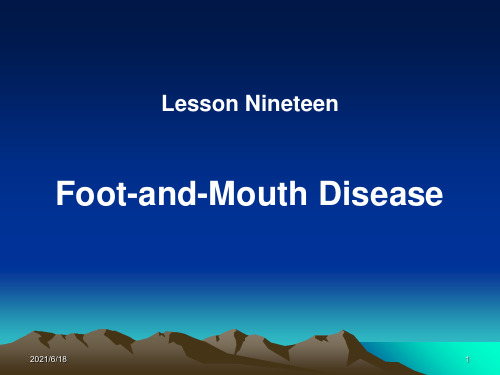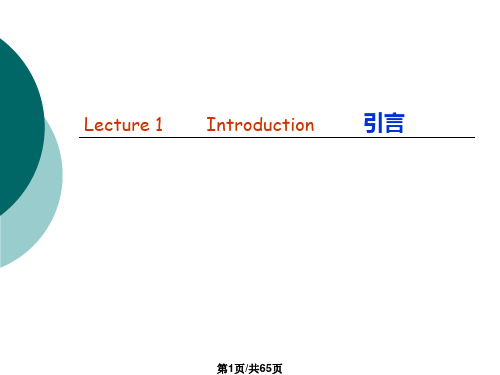兽医专业英语(扬州大学)lesson thirteen.ppt
兽医专业英语

1.-penia 缺乏deficiency, lacke.g leucopenia白细胞减少症erythropenia红细胞减少lymphopenia淋巴球减少症thrombopenia血小板减少症2. -uria 尿症urine conditione.g hematuria血尿症albuminuria 蛋白尿3.-plegia 麻痹瘫痪stroke,paralysise.g thermoplegia热射病paraplegia瘫痪下身麻痹hemiplegia半身麻痹半身不遂4.-odynia paine.g cardiodynia心痛胸痛hepatodynia肝痛enterodynia 肠痛5.-algia paine.g Arthralgia 关节痛Neuralgia神经痛gastralgia 胃痛6.-malacia softening 软化e.g osteomalacia 骨软化encephalomalacia 脑软化7.-ectasia or -ectasis 扩张stretching, dilatation 膨胀扩张e.g nephrectasia肾扩张angiectasis 血管扩张bronchiectasis支气管扩张8.-emia 血症blood conditione.g leukemia白血病bacteremia菌血症septicemia 败血症hypercholesterolemia血胆脂醇过多9.-orrhagia 出血discharge of bloode.g hemorrhage大出血gastrorrhagia 胃出血enterorrhagia肠出血hepatorrhagia肝出血❖简单后缀-y:condition,act,process❖复合后缀-metry -otomy -ectomy -graphy-iatry -ology -pexy,-plasty-(o)rrhaphy -stomy -scopy -megaly10.-scopy 镜检examination,process of examining visuallye.g laryngoscopy喉镜检查bronchoscopy 支气管镜检查法gastroscopy胃镜检查colonoscopy结肠镜检查cystoscopy膀胱镜检查11.-ostomy 造口术process of making an opening into or a connection betweene.g colostomy结肠造口术enteroenterostomy 肠肠吻合术gastrostomy gastroenterostomy胃造口术12.-(o)rrhaphy缝术suturing,process of suturinge.g herniorrhaphy疝缝手术13.-plasty整形术surgical reshaping or repaire.g arthroplasty关节造型术thoracoplasty 轮廓成形术osteoplasty骨整形术14.-pexy 固定术 a fixing or setting firmly in place by suturinge.g hepatopexy肝固定术omentopexy15.-ology 学问学术act or process of studyinge.g pharmacology药理学pathology病理学physiology 生理学16.-logist 专家师one who studies and treatse.g urologist 泌尿科医师physiologist生理学者pathologist 病理学家17.-iatry or –iatrics healing 医师的医疗的药物的e.g Podiatry 足部医疗psychiatry 精神病学18.-graphy 标记符号process of recordinge.g cardiography心动描记法pneumography 肺解剖学electroencephalography脑电图学19.-graph 图表曲线图that which recordse.g cardiograph心动电流图pneumograph呼吸描记器electroencephalograph 脑电图仪20.-gram 图the record itselfe.g cardiogram心电图pneumogram 呼吸描记图electroencephalogram 脑电波21.-ectomy excision,切除术process of cutting oute.g thyroidectomy甲状腺切除术cholecystectomy 胆囊切除术appendectomy 阑尾切除术22.-otomy oncision切开术process of cutting intoe.g thyroidotomy 甲状腺切开术gastrotomy 胃切开术cystotomy膀胱切开术23.-metry 测定法measuremente.g dynamometry 动力测定术pelvimetry盆骨测量24.-megaly 变大largee.g atriomegaly 心房肥大ventriculomegaly 巨脑室splenomegaly 脾肿大hepatomegaly 肝肿大❖简单后缀:-e: an instrument or suffixes of noun.❖复合后缀:-scope -tome -cele -cyte25.-tome 切的刀instrument for cuttinge.g arthrotome 关节刀26.-cyte细胞noun marker,referring to a celle.g leukocyte包细胞lymphocyte淋巴细胞hepatocyte肝细胞lipocyte 脂肪细胞27.-cele疝突出膨大hernia,herniatione.g thyrocele 甲状腺肿hepatocele肝脏突出pneumocele肺彭出omphalocele 脐突出28.-scope镜检instrument for viewinge.g laryngoscope 喉镜检bronchoscope气管镜检celioscope腹腔境gastroscope 胃窥镜29.-itis 炎症inflammatione.g hepatitis肝炎peritonitis腹膜炎gastroenteritis 肠胃炎30.-ist 专家one who specializes in----e.g gastroscopist胃镜医师enterologist肠病学家pathologist病理学家neuropathist 神经病学家31.-or(er)refers to a doer, either a person or thinge.g incisor门齿,切牙32.-osis 症状 a condition, usually abnormal or pathologicale.g sclerosis 硬化症hepatosis 肝机能病gastrosis 胃病nephrosis 肾病33.-oma 肿瘤swelling,tumore.g sarcoma 肉瘤恶性肿瘤fibroma 纤维瘤hepatoma 肝细胞瘤lipoma 脂肪瘤34.-ism a condition, usually the result of a prior condition (先决条件)e.g embolism 栓塞栓子35.-(i)um refers to a part in relation to a whole, related toe.g pericardium 心包膜epigastrium腹上第一腹片bronchium 支气管44.-meter仪表instrument for measuringe.g thermometer 温度计体温计pulmometer 肺量计pulsimeter 脉搏计45.-(o)rrhea释放排放flow,dischargee.g diarrhea腹泻gastrorrhea胃液分泌过多46.-lysis 溶解dissolution;decompositione.g Hemolysis 溶血bacteriolysis 溶菌47.-pathy 病变disease, diseased conditione.g ophthalmopathy hepatopathy 肝病gastropathy 胃病nephropathy 肾病48.-blast 母细胞a cell that is undifferentiated, primitive, embryonice.g hemocytoblast 原始血细胞enteroblast成肠细胞fibroblast 成纤维细胞49.-centesis穿刺术surgical puncture to withdraw fluid enterocentesis thoracocentesis e.g amniocentesis 羊膜腔穿刺术abdominocentesis腹腔穿刺术50.-clysis 灌肠打点滴washing, introduction of fluid for the purpose of irrigatione.g bronchoclysis 野马灌肠51.-ptosis 下垂症a falling, the dropping or sagging of an organe.g nephroptosis 肾下垂hepatoptosis 肝下垂gastroptosis 胃下垂enteroptosis 肠下垂52.-ptysis 吐涎e.g hemoptysis 咯血emptysis 吐血pyoptysis 咯脓53.-(o)rrhexis破裂rupturee.g hepatorrhexis肝破裂54.-sclerosis 硬化症a hardeninge.g arteriosclerosis 动脉硬化hepatosclerosis 肝硬化nephrosclerosis 肾硬化55.-stasis 静止arresting,haltinge.g bacteriostasis 细菌抑制56.-stenosis狭窄 a narrowing, a stricturee.g Arteriostenosis 动脉狭窄57.-emesis 呕吐e.g emetic 催吐要antiemetic 止吐药Word Roots1. cor- or cardi(o)- 心的heart--- cordiform 心形的---cordate心脏形的--- cardialgia 心痛--- cardiogram心电图2. hepato- pref肝liver--- hepatodynia 肝痛--- hepatoma肝细胞瘤--- hepatopathy肝病--- hepatotoxin肝毒素3. pulmo- or pneumo- or pneumat(o)- 肺lung or air--- pulmometry肺容量测定法--- pulmonitis 肺炎--- pneumobacillus 肺炎杆菌--- pneumonectasis 肺气肿--- pneumatolysis 肺气化--- pneumatometer 肺活量计4. lien(o)- or spleen(o)-脾splee--- lienitis 脾炎--- lienectomy 脾切除--- splenotomy 脾切开术--- splenomegaly 脾肿大5. ren(o)- or nephr(o)- kidney--- renin 肾索--- renography肾X线照相术---nephritis 肾炎--- nephrolithiasis肾石病6. oro- or stomat(o)- mouth--- oropharynx 口咽--- oronasal口鼻的--- stomatology 口腔病学--- stomatitis口腔炎7. labio- or cheil(o)- lip--- labiodental唇齿音--- labioplasty唇成形术cheilectropion唇外翻cheiloschisis唇裂8. denti- or odonto- pref. tooth-- dentist--- dentiscalprum牙刮---odontoprosthesis 牙体修复术—odontoseisis牙松动9. linguo- tongue--- lingua舌—linguiform舌装的--- lingulate 舌装的--- linguodental舌齿音10. gingiv- or ulo- 牙龈gum---gingivectomy龈切除术—gingivitis齿龈炎---ulorrhagia龈出血---ulorrhoea 龈糁血11. palato- or urano- 腭palatine---palatitis腭炎---palatogram口盖图---palatograph腭动扫描器palatography腭位图的制作12. pharyngo- 咽pharynxpharyngalgia咽痛pharyngocele咽囊肿pharyngoplasty咽成形术pharyngoplegia咽肌麻痹13. laryngo- 喉larynx,throatLaryngalgia喉痛laryngemphraxis喉阻塞laryngostenosis 喉狭窄laryngoxerosis喉干燥14. esophag(o)- 食管esophagusEsophagectasis食管扩张esophagectopy食管异位esophagocele食管突出esophagotomy食管切开术15. gastr(o)- stomachgastrin 胃泌激素gastrectasia胃胀gastroanastomosis 胃吻合术gastroptosis胃下垂16. enter(o)-肠intestineenterelcosis 肠溃疡enteremphraxis肠阻塞enterorrhagia 肠出血enterocolostomy 小肠结肠吻合术17. colo- or coli- or col- pref结肠. colon colicodynia 结肠痛colimycin结肠霉素coloclysis结肠灌洗colonorrhea粘液性结肠炎18.proct(o)- or archo-直肠rectumProctectomy直肠切除术proctitis 直肠炎proctoscope 直肠镜- proctoscopy直肠镜观察术19.ano-肛门anusAnogenital肛门与生殖器的anorectal肛门直肠的anorectum肛门直肠部anoscope肛门镜20. vesico- or cysti- or cysto- 膀胱bladder Vesicotomy膀胱切开术cystirrhagia膀胱出血cystocele 膀胱彭出cystourethritis膀胱尿道炎21. thoraco- chest or 胸thoraxThoracocyllosis胸畸形thoracicolumbar 胸腰的thoracoschisis 胸裂thoracoplasty胸廓成形术22. ventro- or coeli(o)- or laparo- 腹部belly、abdomenVentrotomy剖腹术coelialgia腹痛Coeliorrhaphy腹腔缝术laparotome剖腹术23. bili- or chole-胆bilebilichol 胆汁醇- biligenic生胆汁的cholecyst胆囊cholelithiasis胆石病24. oculo- or ophthalmo- eyeoculist 眼科医生oculomotor 眼球运动的ophthalmoplegia眼肌麻痹ophthalmoscope检眼镜25. lacrimo- or dacryo-眼泪tearlacrimator 催泪物质-lacrimal 泪腺的lacrimatory agent 催泪剂lacrimation 泪26. palpebro- or blepharo-眼睑eyelidpalpebra 眼睑palpebral 眼睑的blepharochalasis 眼睑皮肤松弛症blepharospasm眼睑痉挛27. kerato-角角质horn or comeakeratectasia 角膜膨胀keratinase 角蛋白酶keratoplasty 角膜成形术keratosis角化症28.auri- or oto- earauriphone 助听器auristilla滴耳剂otorrhea耳液溢,耳漏otosclerosis 耳硬化症29.naso- or rhino- noseNasitis鼻炎nasopharynx 鼻咽rhinocleisis鼻腔闭塞rhinocnesmus 鼻痒30.broncho- or bronch- 支气管pref. bronchus; bronchialBronchiectasis支气管扩张bronchiolitis细支气管炎bronchorrhagia支气管出血bronchospasm支气管痉挛31. gonado- 生殖腺seedGonadectomy性腺切除术gonadotrophin 促性腺激素gonadotrope 生殖腺32. andro- 男的雄性的maleandrocentrism大男子主义androgen 雄激素andrology 男科学androsterone 雄淄酮33. gyne- or gyneco- femaleGynecic女性的gynecium 雌蕊雌蕊群gynecologist 妇科医生gynecopathy 妇科病34. vagino- or colpo- 阴道vaginaVaginectomy阴道切除术vaginotomy阴道切开术colpoptosis阴道下垂colporrhaphy阴道缝合术35. oophor- 卵巢ovaryOophorectomy卵巢切除术oophorectomize切除。
临床兽医学专业英语

Acknowledgements
• … wishes to express his sincere appreciation to… for… • … thank… for… • … is grateful to for… • We wish express our thanks to… • Thanks are due to… for… • This work was supported in part by… • Support by … is gratefully acknowledged. • Acknowledgement is made to …for…
More short form sentences led by “as”
• • • • For example: As have stated above As in figure 3 As the illustration shows As follows
More passive voice
Part I How to Make Use of the Linguistic Features of Scientific Papers
Vocabulary---basic elements
Typically professionalized terms--Specifically concentrated meaning--Absorb----take in Observe---look at
临床兽医学专业英语
Specialized English in Clinical Veterinary Medicine
授课教师:唐兆新教授 授课时间:2006年9月-2007年1月
Lesson 7
畜牧兽医专业英语课件

(3) 国际交流合作 专业英语表达、听说、应变能力
Chapter 2 Features of Specialized English
第二章 专业英语的特点
2.1 Grammar Features 语法特点
客观性(Objective)、准确性(accuracy)和精练性(conciseness)。 (1) 广泛使用被动语态 (2) 广泛使用非谓语形式 (3) 省略句使用频繁 (4) It句型和祈使句使用频繁 (5) 复杂长句使用频繁 (6) 后置形容词短语作定语多
object.
传导电流意味着电子在物体内的流动
2.1 Grammar Features
② 分词
过去分词短语替代从句中的被动语态 现在分词短语替代从句中的主动语态
1)The power supply, which is shown in block-diagram in Fig.1, is a single-phase switch-mode inverter.
在设计一个新的电子产品之前,我们必须做各种实验
✓用动名词短语做主语
4) Changing resistance is a method for controlling the flow of the
current.
改变电阻是控制电流的一种方法
5) Conducting electricity means the flow of electrons through an
2)Instrument transformers are installed on the high-voltage equipment. 互感器安装在高压设备上
兽医专业英语(扬州大学)l课件

兽医专业英语( 扬州大学)课件, 包括兽医的定义, 兽医的历史, 兽医专业的作用 和义务, 动物福利和伦理。
导论︰兽医学简介
1 兽医学定义
介绍兽医学的定义和领域。
3 兽医学的职责
探讨兽医在兽医学领域中的作用和责任。
2 兽医学的历史
回顾兽医学的发展历程。
4 动物福利与伦理
题
讨论异国和野生动物医学中的伦理和法律问题。
介绍在兽医医学中常用的药物和药物治疗方法。
药物的副作用和毒性
介绍药物的副作用和毒性,以及如何预防。
药物的给药方法和剂量
探讨药物的给药方法,正确剂量的重要性。
替代疗法
讨论药物治疗之外的替代疗法。 Nhomakorabea公共卫生与人畜共患病
1
人畜共患病及其控制
介绍人畜共患病的种类和控制策略。
2
食品安全和检验
讨论食品安全和检验的重要性。
探讨兽医实践中的财务管理和会计。
沟通与客户关系
讨论兽医实践中的沟通和客户关系。
异国和野生动物医学
1 异国和野生动物医学原则
介绍异国和野生动物医学的基本原则。
3 常见疾病和情况
介绍异国和野生动物常见的疾病和情况。
2 异国动物的饲养和繁育
探讨异国动物的饲养和繁育方法。
4 异国和野生动物医学中的伦理和法律问
3
公共卫生政策和法规
探讨相关公共卫生政策和法规。
4
新兴疾病
讨论新兴疾病对公共卫生的挑战。
动物行为与福利
动物行为和学习 动物的压力和攻击行为 动物福利和伦理考虑 兽医行为医学
兽医实践管理
小型动物兽医实践管理
探讨小型动物兽医实践的管理方法。
兽医学讲稿PPT课件

第一章 临床检查的基本方法与程序
兽医临床诊断学作为一门专业基础学科, 是有其道理的,学习者从中学到的是怎么样去调查, 收集资料,采取怎样的方法获得症状资料,还有实 验室常规粪、尿、血的检查,最后对所有资料进行 综合分析,做出初步判断。
综合分析→判断,很难,要求有丰富的工作经验, 必要时辅以先进的实验室检测手段。
NMR波谱技术今后最富有前景的应用领域有以下几个方面:
①继续帮助有机化学家从自然界寻找具有生物活性的新颖有 机化合物,今后这方面的研究重点是结构与活性的关系。
②更多地用于多肽和蛋白质在溶液中高次构造的解析,成为 蛋白质工程和分子生物学中研究蛋白质结构与功能关系的重 要工具。
③NMR技术将广泛用于核酸化学,确定DNA的螺旋结构的类型 和它的序列特异性。
③痘疹:是痘病毒侵害皮肤的上皮细胞而形成的结节 状肿物。 经过:红斑、血疹、水泡、脓疱、结痂。
④水泡、脓疱 特点: 如:猪水泡病、口蹁疫
⑤荨麻疹:由于皮肤的马氏层和乳头层发生浆液浸润, 动物体表发生许多圆形或椭圆形、蚕豆大至核桃大、 表面平坦的隆起。
8、皮肤完整性破坏的检查
①溃疡
②褥疮
③瘢痕
第三节 可视粘膜检查
④NMR技术对于糖化学的应用将显示出越来越大的潜力,采 用NMR技术来测定寡糖的序列,连接方式和连接位置,确定 糖的构型和寡糖在溶液中的立体化学以及与蛋白质相互作用 的结构特征和动态特征将是重要的研究领域。
⑤NMR技术将更多地用于研究动态的分子结构和在快速平衡 中的变化。
⑥NMR技术将进一步深入生命科学和生物医学的研究领域, 研究生物细胞和活组织的各种生理过程的生物化学变化。
狭义的诊断是对患病动物的本质所做出的判断。具 体而言,就是将问诊,体格检查、实验室检验、特殊 检查及病理剖检的结果,根据医学理论和临床经验, 再通过分析、综合、推理对疾病的本质所做出的判断。
兽医专业英语(扬州大学)混合感染的多种亚型禽流感病毒的纯化

•
关键词:禽流感,泄殖腔棉拭样品,混合感染,新城疫,水禽
•*通讯作者, tel: +86 514 8797 2247; fax: +86 514 8797 2591; e-mail: springyz@
Isolation and purification of Avian influenza virus (AIV) from cloacal samples of waterfowl
– 荧光定量PCR( real-time reverse transcription polymerase chain reaction, rRTPCR)
•
•
– 鸡胚分离
– 反转录PCR( reverse transcription polymerase chain reaction, RT-PCR)
水禽常规aiv监测主要是通过采集大量的泄殖腔棉拭样品这些样品通过荧光定量pcrrealtimereversetranscriptionpolymerasechainreactionrrtpcr检测为阳性但是鸡胚未分离到病毒
摘要练习
• 背景:禽流感病毒(Avian influenza viruses, AIVs) 是重要的动物传染病病原, 其自然宿主为水禽。除了AIV,水禽常常会共感染其他病毒,如副粘病毒,其 中由于新城疫病毒( Newcastle disease virus,NDV)某些毒株对家禽高度致 病也具有特别意义。 目的:在水禽常规AIV监测,假设如果一个样品中同时存在NDV和AIV,NDV 可能超过AIV生长产生AIV假阴性。本研究的目的就是为了消除这种AIV假阴 性 方法:样品:泄殖腔棉拭样品( cloacal samples )
•
兽医专业英语(扬州大学)l(1)

particularly the African Cape buffalo(非洲
水牛), which is commonly found to be
infected with more than one of the SAT
virus types even in areas where foot-and-
2route of infection in ruminants(反刍动 物) is through the inhalation of droplets(飞沫), but ingestion of infected food, inoculation with contaminated vaccines, insemination with contaminated semen, and contact with contaminated clothing, veterinary instruments, and so on can all produce infection. In animals infected via the respiratory tract, initial viral replication occurs in the pharynx (咽), followed by viremia spread to other tissues and organs before the onset of clinical disease.
曾经 )in Australia. From 1880 onward,
the control of rinderpest (牛瘟)and the
improved husbandry in the livestock
industries in Europe focused attention on
畜牧兽医专业英语课件PPT课件

value of the desired unit. 这些仪表可以被校准并且设计了不同的量程 ,以便读出期望的数值。
5) Electrical energy can be stored in two metal plates separated by an insulation medium. Such a device is called a capacitor, and its ability to store electrical energy is termed capacitance. It is measured in ’Farads.
Lecture 1 Introduction
引言
第1页/共65页
1.1 什么是专业英语
普通英语(Common English, Ordinary English)
科技英语(English for Science and Technology)
专业英语(English for Special Science and Technology)
第16页/共65页
三、科技英语的语法特点 (Grammar Features)
3. 定语从句中的省略
1) The use of antibiotic growth promoters, which are mainly supplemented in animal feed to boost production and prevent disease outbreaks, has been banned due to fears of antibiotic-resistant microbes in the food chain.
兽医专业英语(扬州大学)lesson fou

a
7
• Brucellosis is essentially a disease of the sexually mature animal, the predilection sites being the reproductive tracts of males and females, especially the pregnant uterus. Allantoic factors stimulate the growth of most brucellae. These factors include erythritol, possibly steroid hormones and other substances. Erythritol is present in the placenta and male genital tract of cattle, sheep, goats and pigs but not humans. Erythritol does not stimulate the growth of B. ovis and inhibits B. abortus strain 19, the attenuated vaccinal strain.
a
3
• The brucellae are aerobic and capnophilic, catalase-positive, oxidase-positive (except B. ovis and B. neotomae), urease-positive (except B. ovis) and will not grow on MacConkey agar.
dogs. B. abortus is excreted in bovine
- 1、下载文档前请自行甄别文档内容的完整性,平台不提供额外的编辑、内容补充、找答案等附加服务。
- 2、"仅部分预览"的文档,不可在线预览部分如存在完整性等问题,可反馈申请退款(可完整预览的文档不适用该条件!)。
- 3、如文档侵犯您的权益,请联系客服反馈,我们会尽快为您处理(人工客服工作时间:9:00-18:30)。
• The lymph nodes are the sites where B and T cells respond to antigens that are collected by the lymph draining peripheral tissues. Lymphocytes in the spleen respond to bloodborne antigens. Both lymph nodes and spleen are organized into B cell areas (follicles) and T cell areas (parafollicular zones). The T cell areas are also the sites of residence of mature dendritic cells, which are accessory cells specialized for the activation of naïve T cells. Follicular dendritic cells reside in the B cell areas and serve to activate B cells during humoral immune responses to protein antigens. The development of secondary lymphoid tissue architecture depends on cytokines.
• Accessory cells function to promote the activation of lymphocytes and to perform effector functions that may be enhanced by humoral or cell-mediated adaptive immune responses. Accessory cells include mononuclear phagocytes, dendritic cells, and follicular dendritic cells.
• Follicular • Hematopoietic • Residence • Architecture • Cytokines • Langerhans cell • Gastrointestinal • Tonsil • Recruit • Microbial • Vascular endothelial cells
• Some of the progeny of antigen-activated B and T lymphocytes differentiate into memory cells that survive for long time periods in a quiescent state. These memory cells are responsible for the rapid and enhanced responses to subsequent exposures to antigen.
• The mucosal immune system includes specialized collections of lymphocytes and accessory cells organized to optimize encounter with environmental antigens introduced through the respiratory and gastrointestinal and genitourinary tracts. Peyer’s patches in the intestinal wall and the tonsils in the oropharynx are examples of mucosal immune system tissue.
Text
• The anatomic organization of the cells and tissues of the immune system is of critical importance for the generation of immune responses. This organization permits the small number of lymphocytes specific for any one antigen to locate and respond effectively to that antigen regardless of where in the body the antigen is introduced.
• B and T lymphocytes express highly diverse and specific antigen receptors and are the cells responsible for the specificity and memory of adaptive immune responses.
• The cutaneous immune system consists of specialized collections of accessory cells and lymphocytes adapted to respond to environmental antigens encountered in the skin. A network of immature dendritic cells called Langerhans cells is present in the epidermis of the skin that serves to trap antigens and then transport them to drainymphocyte recirculation is the process by which lymphocytes continuously move between sites throughout the body through blood and lymphatics, and it is critical for the initiation and effector phases of immune responses. Naïve T cells normally recirculate among the various peripheral lymphoid organs, increasing the likelihood of encounter with antigen displayed by antigen-presenting cells such as mature dendritic cells. Memory and effector T cells more typically are recruited to peripheral sites of inflammation where microbial antigens are located
• The adaptive immune response depends on antigen-specific lymphocytes, accessory cells required for lymphocyte activation, and effector cells that eliminate antigens.
• The organs of the immune system may be divided into the generative organs (bone marrow and thymus), where lymphocytes mature, and the peripheral organs (lymph nodes and spleen), where naïve lymphocytes are activated by antigens.
Lesson Thirteen
Immune System
New words and phrases
• Anatomic • Receptor • Nomenclature • Precursor • Thymus • Naive • Progeny • Quiescent • Humoral • Mononuclear • Phagocyte • Dendritic
• Naïve B and T cells are mature lymphocytes that have not been stimulated by antigen to become differentiated lymphocytes. When they encounter antigen, they differentiate into effector lymphocytes that have functions in protective immune responses. Effector B lymphocytes are antibody-secreting plasma cells. Effector T cells include cytokine-secreting CD4+ helper T cells and CD8+ cytolytic (or cytotoxic) T lymphocytes (CTLs).
• Both B and T lymphocytes arise from a common precursor in the bone marrow. B cell development proceeds in the bone marrow, whereas T cell precursors migrate to and mature in the thymus. After maturing, B and T cells leave the bone marrow and thymus, enter the circulation, and populate peripheral lymphoid organs.
